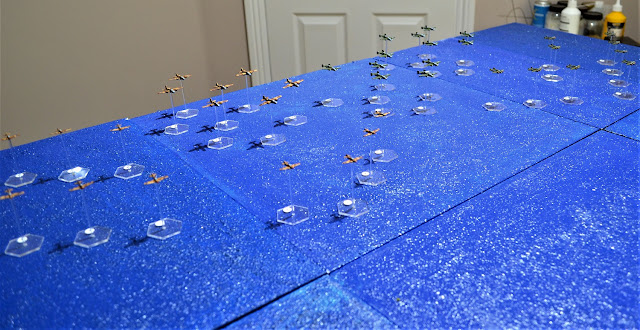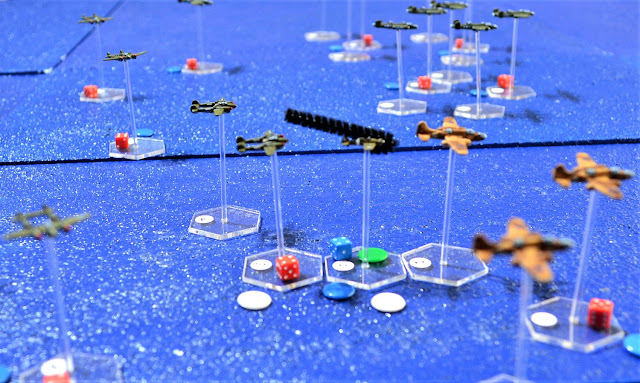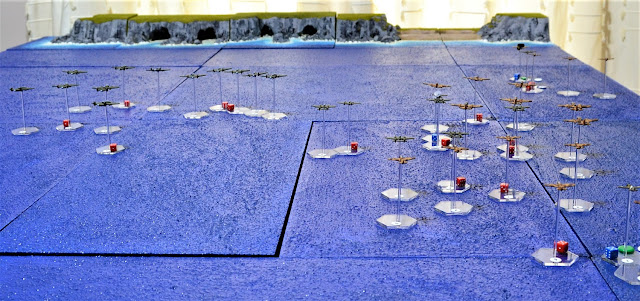Hoping to replicate their success on the Maritza airfield raid, a combined allied bomber formation escorted by fighters set out from Cyprus to bomb the other Rhodes airfield at Cattavia.
In total, 12 Mitchell and 7 Boston bombers are escorted by 10 Hurricanes and 9 P38 Lightning fighters.
Continued -
In total, 12 Mitchell and 7 Boston bombers are escorted by 10 Hurricanes and 9 P38 Lightning fighters.
 |
| P38 fighters with Mitchell bombers in the background |
 |
| Closeup of Mitchell bombers. |
As the allied force nears Rhodes they are intercepted by the ME110 CAP.
In response to the sighting, all available fighters at Cattavia are scrambled to intercept the allies. Unfortunately for the Axis forces this only consists of a further 2 x ME110's and 2 x Italian Saetta fighters.
 |
| An overview of the allied force |
By the end of move 1 the remaining allied bombers and fighters continue towards their destination. So far none have been spotted by the German fighters.
The P38's successfully bounce the German CAP. Swooping behind them they get on the tails of the ME110's. In the foreground the German Junior Ace squadron leader has conducted a Split-S manoeuvre whereby the plane dives dropping a level and inverts itself facing the opposite direction. It is the US squadron leader's regular pilot wingman that is on the tail of the ME110 and he successfully follows the German fighter through the hard manoeuvre and remains on his tail. The US squadron leader replicates the move keeping formation with his wingman.
In the distance the Sprog ME110 pilot attempts to replicate his squadron leader but fails and continues in a straight line followed by the P38 tailing him.
By the end of move 2 the allies have made further progress. The Hurricanes' red section in the lead has been spotted by the ME110's.
Axis sparse reinforcements arrive.
A Junior Ace pilot of a P38 uses his skill to pour a devastating long burst from his 20mm cannon and machine guns into the ME110's Junior Ace squadron leader. As the ME110 begins its death plunge the pilot manages to extricate himself and parachutes to safety.
The leading red section of Hurricanes head out towards the US wing where the handful of Axis fighters are concentrating their attack.
The RAF Bostons have yet to be spotted as they continue towards Rhodes.
An overview of the bombers progress with the Saettas and ME110's in the far distance.
The surviving Sprog piloted ME110 attempts to manoeuvre behind the Mitchells but is shadowed by a pair of P38's
The Italian Saetta fighters lead the Axis attack in the foreground followed by the pair of reinforcing ME110's.
The Saettas manage to evade the escorting P38's with the lead Saetta Junior Ace pilot (number 1) performing an overhead pass attack on a Mitchell bomber. His less experience wingman fails to mirror him and flies off over the Mitchell formation. The Saetta Ace dives down from level 6 to pours a short burst towards the Mitchell before passing beneath him and levelling out at level 4. Although he failed to damage the Mitchell he forced the plane out of formation.
An unspotted P38 in the foreground 'bounces' an ME110 who had broken away from his Sprog wingman to attack the Mitchells.
The pair of Saettas, having extricated themselves from the Mitchell bomber formation, begin a move on the Hurricanes and Bostons.
It does not appear to be the German's day as more ME110's suffer at the hands of the P38's. Top of the photo the port engine of an ME110 is destroyed by a long burst from a tailing P38. In the foreground an ME110 suffers critical instrument damage and as it is piloted by a sprog it will have to head for home. The P38's are faster aircraft and therefore the tailing aircraft here peels away rather than overshoot and finding itself in the ME110's sights.
The last surviving in tact ME110 piloted by a Sprog is the focus of attention by the Top Ace P38 squadron leader and his wingman.
The US Ace has some difficulty in getting on the tail of the ME110. It is proving to be elusive! A change of tack and some nifty tight turns, the Ace conducts an overhead passing attack pumping a short burst into the ME110 as the P38 dives on it from above. A serious fire is started on the ME110 but it is still in the air.
The first chance it gets to put out the fire and a '6' is rolled! The fire is promptly extinguished and the Sprog pilot now opens up his throttles and aims his fighter at the Mitchell bombers ahead of him.
The 3rd Schwarm Rottenfuhrer loses height as he tries to put some distance between him and the mass of allied aircraft. The P38 that had caused the damage is intent on finishing the job and stays on his tail.
Hurricanes and P38's attempt to take out the 2 x Saettas but it proves to be like trying to swat flies!
A Saetta momentarily gets on the tail of a Boston bomber but in turn is tailed by a P38. The latter opens fire first damaging the Saetta's engine.
The Junior Ace Saetta squadron leader gets on the tail of a Hurricane. He fires off a long burst scoring 7 hits which only translates to the cockpit being damaged (A '2' was thrown on a D10!). He gets another chance and fires off a second burst. Again 7 hits scored, and the dice result? '2' again! The Hurricane has become a convertible! But it is still in the air and able to fight.
In his determination to shoot down the Hurricane, The Italian Ace failed to notice another Hurricane section manoeuvring behind him. One Hurricane piloted by a Regular successfully gets on the tail of the Saetta.
At the end of this turn it is looking rather bleak for the Axis forces.
The Top Ace P38 pilot was determined to finish off the Sprog ME110, and after weaving into position finally finished him off with a long burst causing the German fighter to explode.
Rhodes comes into view on the horizon.
The Italian Saetta Junior Ace Squadron Leader has fired a last burst of machine gun fire and suffered jammed guns. Having slipped from the tail of the Hurricane to his front the Hurricane tailing him rakes his plane with 20mm cannon and machine gun fire. The Italian Ace suffers critical instrument damage. He is still in the air but must now make for home.
The Italian Ace's wingman is not so lucky. Having already suffered engine damage, the P38 Blue Section Veteran Element Leader comes up on his tail and shoots him down. The pilot successfully bails out.
The Rottenfuhrer's experience flying the last ME110 is becoming epic. With his port engine destroyed he nurses his crippled plane towards land and safety with a swarm of allied fighters following him determined to finish him off. His plane is now at 5,000 ft (level 2) gradually losing altitude as it approaches the coast.
The ME110's rear gunner fires at the pursuing P38 without success. The P38 fires another long burst into the ME110 hitting the cockpit and killing the rear gunner.
As one P38 peals away it is replaced by another. This time a Regular Wingman from Green Section. It's first burst of fire inflicts critical instrument damage to the ME110 but it is still in the air! However, the long burst has used up so much ammo, the P38 is down to almost his last round. A final burst empties his ammo but to no avail.
The ME110 loses altitude once again and approaches the coast at 1,000 ft (level 1). The pursuing P38's are called off to prepare for the attack on Cattavia and sure that the ME110 is doomed.
Mitchell bombers now clear of enemy fighters begin to organise themselves as they approach Rhodes.
Another drama being played out was that of the Italian Ace Saetta pilot. As he nursed his badly damaged fighter towards Rhodes he seemed to lead a charmed life with the swarm of allied fighters around him failing to knock him down. The US Top Ace P38 Squadron Leader swooped in to show how it is done. He fired a long burst at long range shooting down the Italian fighter. Sadly, the Italian Ace pilot failed to bail out as his plane bega its plunge into the sea.
The P38's now breaking off to prepare for the attack on Cattavia airfield. The demise of the Italian Ace is imminent as his plane spirals down.
The crippled ME110 finally crosses land. And its fate? I calculated it would take about 3 moves to reach its airfield at Cattavia. A roll of 1 - 3 on a D6 would result in him crash landing. The D6 was rolled 3 times and it passed them all! However, as it lands on the airstrip the rumble of bombers would have been heard overhead.
The allies now reforming as the coastline approaches.
An overview of the allied force about to hit Cattavia.
Air attack on Cattavia airfield:
As before this will be conducted in the abstract rather than setting up the tabletop.
A total of 19 bombers approached the airfield at high altitude. An 88mm Flak battery was positioned at the airfield providing for long range AA fire. As the bombers approached, the 88mm opened up downing one Mitchell bomber and damaging another.
The remaining bombers dropped their medium bombs scoring 6 hits and 2 near misses with the following results:
3 hits on the runway.
1 building damaged
1 building set on fire
Light damage to the apron and dispersal areas
The airfield would be out of action for the rest of the day until adequate repairs had been made.
Additionally, a Saetta fighter was damaged. As it was already in a damaged state this resulted in the aircraft being destroyed.
Fallschirmjagers were present at the airfield. One bomb landed directly on 'A' company destroying one platoon (1 base).
As the bombers departed, the Hurricane and P38 fighters approached the airfield at low level.
The fighters ran into very accurate AA fire from the 20mm and 88mm guns positioned around the airfield. 3 aircraft were shot down (1 x P38 and 2 x Hurricanes) with 2 damaged (1 of each). The biggest loss was that of the P38 Top Ace Squadron Leader who, leading the charge, plunged into the ground as he met the full force of AA fire.
The surviving aircraft pressed home their attack targeting the planes situated around the airfield.
The Hurricanes destroyed 4 and damaged 1 with the P38's destroying 1 and damaging 3.
This resulted in the following:
JU52's - 4 x destroyed, 3 x damaged, 1 x undamaged.
Saetta fighters - of 3 already damaged, 1 was destroyed and another received further damage and hence destroyed.
The ME110 that had just landed received further damage and thus also destroyed.
The final tally:
Allies
Fighters - 3 x destroyed, 3 x damaged
Bombers - 1 x destroyed, 1 x damaged
Axis
Fighters - 9 x destroyed
Transports - 4 x destroyed, 3 damaged.
Overall a substantial victory for the allies. With both Rhodes airfields badly mauled the task of gaining air superiority has swung in favour of the allies at this stage.










































A great report..not surprised the Italians and the Luftwaffe had a tough time!
ReplyDeleteMany thanks Jim. Aside from being hopelessly outnumbered, luck was not on their side either with poor dice rolls! Which makes a change as so far it is the allies who have been on the receiving end of awful dice rolls.
DeletePoor dice rolls, sprogs and complex manoeuvres...not a god combination!
ReplyDeleteYep, the Sprogs certainly struggled.
DeleteInteresting campaign, fun to follow. Thanks.
ReplyDeletePleased you are enjoying it Anthony.
DeleteVery entertaining once again... provided you weren't an Axis pilot this time!
ReplyDeleteThanks Peter.
DeleteYou have built up an impressive order of battle. A good story well told.
ReplyDeleteThanks Norm.
DeleteGreat scenario, Jon. I find painting WW2 aircraft and armour more fun than infantry and cavalry. And I have spent many a happy hour browsing the Wings Palette site which is a fantastic resource for plane camo and insignia.
ReplyDeleteThat's a very useful site which I have added to my bookmarks. Thanks again for the heads-up. I find it is a nice change to paint up aircraft and armour after a production line run of figures. Keeps my painting mojo fresh.
DeleteJon, you probably know this but on WP select (say) WW2 fighters. An alphabetical list comes up on the left. Click on the type. Then you have to click on the country to bring up the full list and you can either scroll the lot or select pages depending on the date you're interested in. Click on the image to enlarge. Note that some profiles give only side on views but others give top, bottom etc and some give relevant colour details.
ReplyDeleteThanks for the info. I have had a quick look and it appears very extensive. When I get around to painting the next batch of aircraft I can certainly see using this as a guide.
Delete